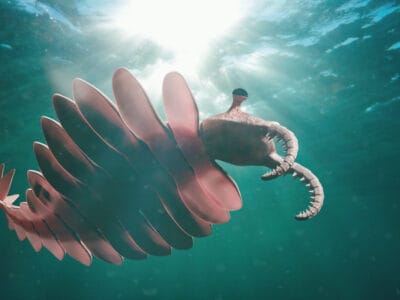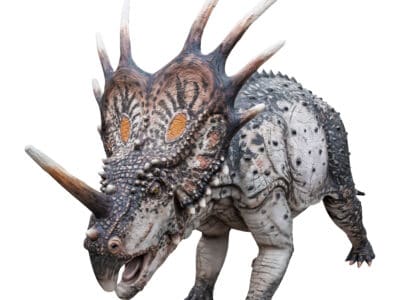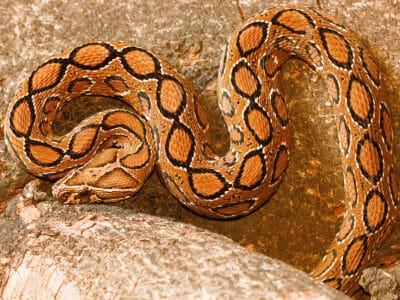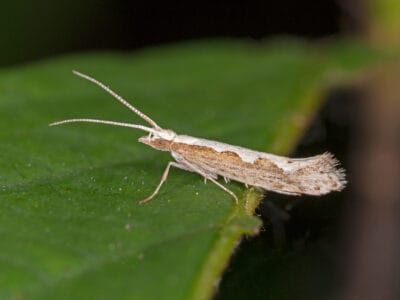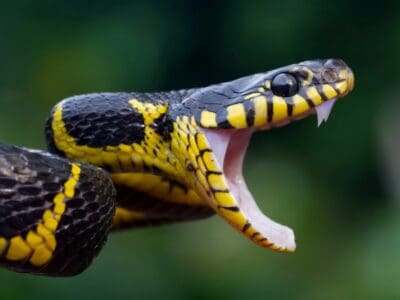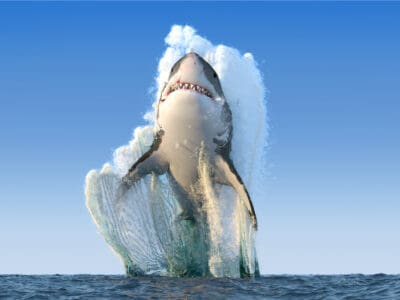Eastern Coral Snake
.jumbotron {
background-image: url(“https://a-z-animals.com/media/2022/04/Eastern-Coral-Snake-header-400×300.jpg”);
}
}
@media only screen and (min-width: 641px) and (max-width: 920px) {
.jumbotron {
background-image: url(“https://a-z-animals.com/media/2022/04/Eastern-Coral-Snake-header-470×370.jpg”);
}
}
@media only screen and (min-width: 921px) {
.jumbotron {
background-image: url(“https://a-z-animals.com/media/2022/04/Eastern-Coral-Snake-header.jpg”);
}
}
Eastern Coral Snake
Micrurus fulvius
One of the most dangerous snakes in the USA.
Eastern Coral Snake Scientific Classification
- Kingdom
- Animalia
- Phylum
- Chordata
- Class
- Reptilia
- Order
- Squamata
- Family
- Elapidae
- Genus
- Micrurus
- Scientific Name
- Micrurus fulvius
Read our Complete Guide to Classification of Animals.
Eastern Coral Snake Conservation Status
Eastern Coral Snake Facts
This post may contain affiliate links to our partners like Chewy, Amazon, and others. Purchasing through these helps us further the A-Z Animals mission to educate about the world’s species..

Discover alligator-eating snakes, spiders larger than your phone, and 1000 more incredible animals in our daily FREE email.
.photo-gallery {
–margin: 0px auto 0px;
–padding: 0px 0px 0px 0px;
}
.gallery-link {
background-image: url(“https://a-z-animals.com/media/2022/04/Eastern-Coral-Snake-header-1024×614.jpg”);
background-repeat: no-repeat;
background-size: cover;
background-position: center;
height: 500px;
justify-content: center;
text-align: center;
align-items: center;
display: flex;
border: 2px solid #000;
}
.gallery-link img {
height: 50%;
}
@media only screen and (max-width: 768px) {
.gallery-link {
height: 300px !important;
}
}
View all of the Eastern Coral Snake images!
“The Eastern Coral Snake is described as ‘Beautiful and Dangerous’”
Also called the harlequin snake, this slender, jewel-toned elapsid is one of the most beautiful in the United States, with its bands of red, yellow, and black. It’s also one of the most dangerous, as it produces a paralyzing neurotoxin. The good news is that it’s shy, likes to hide, and it takes a lot of provocation for it to bite a human. It is best to admire it from a bit of a distance. Read on for more information about this pretty reptile.
Four Amazing Facts About Coral Snakes
Here are four facts about the coral snake.
button.pulse {
transform: scale(1); animation: pulse 2s infinite;
box-shadow: 0 0 0 0 rgba(11, 247, 25, 1);
}
@keyframes pulse {
0% { transform: scale(0.90); box-shadow: 0 0 0 0 rgba(11, 247, 25, 0.5); }
60% { transform: scale(1); box-shadow: 0 0 0 15px rgba(11, 247, 25, 0); }
100% { transform: scale(0.90); box-shadow: 0 0 0 0 rgba(11, 247, 25, 0); }
}
- The coral snake has a host of nonvenomous imitators. Among them are the scarlet kingsnake, the scarlet snake, and the red milk snake.
- It is not above eating other coral snakes.
- There are only about 100 coral snake bites every year in the United States, but they need to be taken very seriously.
- The coral snake’s fangs are small in size, so when it bites it needs to hang on and sort of chew to work the venom into the victim.
Where To Find Eastern Coral Snakes
Eastern coral snakes are only found in the southeastern part of the United States. It prefers habitats that provide hammocks and flatwoods that feature slash pine and saw palmettos or somewhat arid, open, sandy locations that don’t have too much vegetation. It’s also found in scrubby forest habitats near the coasts of North and South Carolina.
Eastern Coral Snake Scientific Name
The eastern coral snake’s scientific name is Micrurus fulvius. Micrurus comes from the Greek words for “small” which is mikros and “tail” which is oura. Fulvius is Latin for “orange-yellow,” which described a reptile whose bright red color had faded somewhat. Whether the eastern coral snake has subspecies and how many is a little controversial. The Integrated Taxonomic Information System, for example, does not list subspecies for this snake, while other places list:
- M.f. fitzingeri
- M.f. microgalbineus
- M.f. fulvius
- M.f. tenere
- M.f. barbouri
Other experts believe these snakes are either not valid subspecies or, as in the case of M.f. tenere, their own species.
The Different Types of Coral Snake
Even if there’s only one type of eastern coral snake, there are many species in the Micrurus genus. Micrurus tener, which is sometimes thought to be a subspecies of M. fulvius, is the Texas coral snake. Its range is from the southern United States and down into Mexico. M. tener itself has five subspecies.
The Argentinian coral snake, M. pyrrhocryptus, lives in South America and is partial to the hot and dry habitat of the Dry Chaco, which is shared by northern Argentina, eastern Bolivia, and some of Brazil, and western Paraguay.
The location of Bogert’s coral snake, M. bogerti is southern Mexico. Its conservation status is data deficient, but it is protected by law. The Oaxacan coral snake, M. ephippifer has a range that extends from the tropical deciduous forests of coastal Oaxaca to the Isthmus of Tehuantepec. It has two subspecies, and its conservation status is vulnerable.
How To Identify Coral Snakes: Appearance and Description
Micrurus coral snakes such as the eastern coral snake are found in the New World, which is North, Central, and South America. They are graceful, slender snakes whose length ranges between 2 and 3 feet when they’re mature, though some have grown to over 4 feet. The weight of the snake is between 2 and 5 pounds, depending on its size.
In the U.S., the adage “red touch yellow, kill a fellow,” usually does apply to a coral snake unless they are some sort of mutation. However, the further south you go into Mexico and Central and South America, the adage doesn’t necessarily apply.
The eastern coral snake has a black snout followed by a band of yellow, then black, then yellow or white, then red, then yellow then black all the way down to the tail. It has 15 rows of smooth scales on its body and a divided anal plate. Females are longer than males. Unlike other venomous snakes such as rattlers, the fangs of the coral snake are small and do not fold back into its mouth when its mouth is closed.
Eastern Coral Snake Pictures
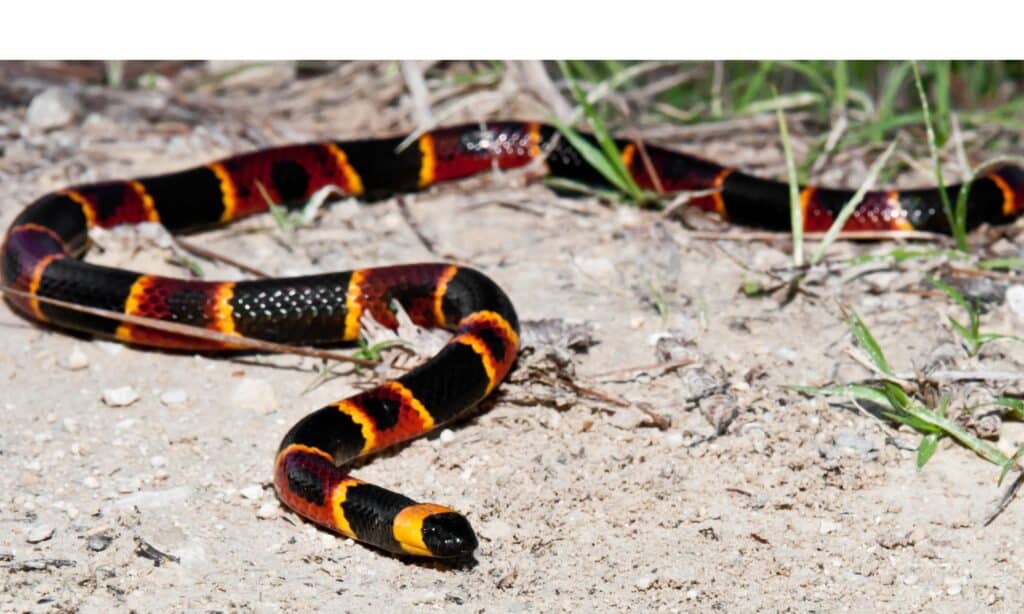
iStock.com/JasonOndreicka
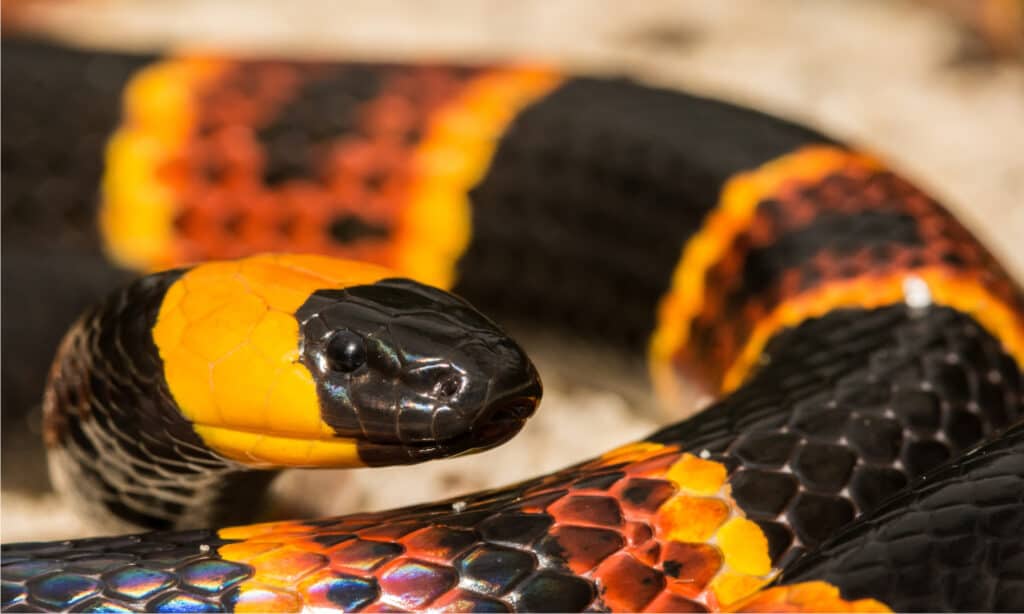
Jay Ondreicka/Shutterstock.com
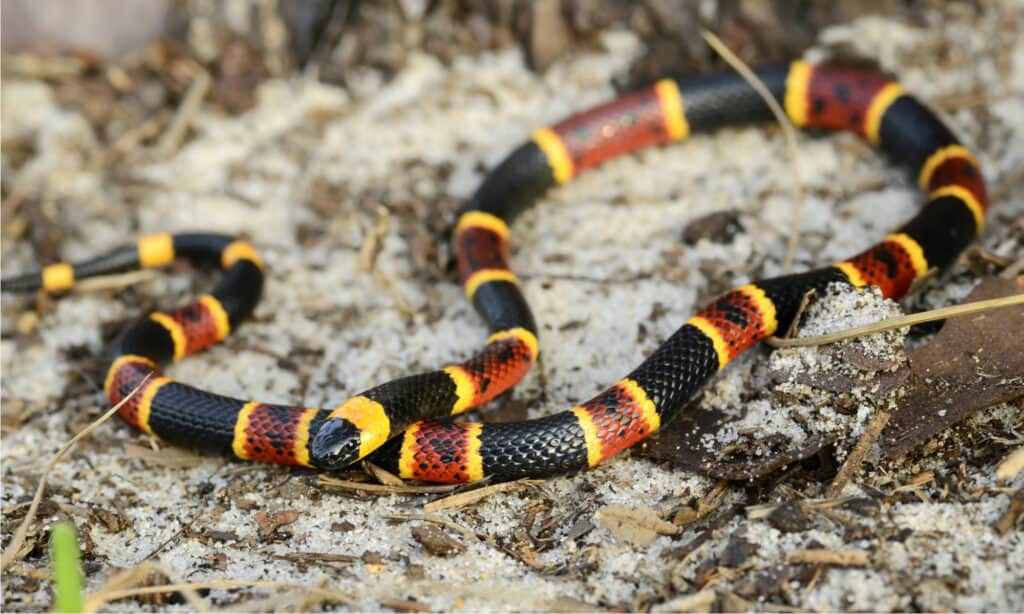
Patrick K. Campbell/Shutterstock.com
Eastern Coral Snake Venom: How Dangerous Are They?
The coral snake is one of a handful of truly dangerously venomous snakes that live in North America. Its venom is a neurotoxin, which means it attacks the nervous system. When the snake bites its prey the venom paralyzes and then kills them. Humans who get a lethal bite can die because their respiratory system is paralyzed. Yet, death from the bite of a coral snake is rare in the United States. The snake is fossorial, which means it burrows and is somewhat shy. Even when eastern coral snakes do bite, health professionals believe that as many as 60 percent of the bites are dry.
Eastern Coral Snake Behavior and Humans
Eastern coral snakes tend to be secretive, and many people are surprised when they find one living rather close to their home or even in their home. Unlike many other snakes, it doesn’t seem to prefer small mammals such as rats or mice but is more likely to take frogs, fish, insects, birds, lizards, and even other snakes. The coral snake is not aggressive toward humans. It’s not eager to bite to defend itself but will try to get away first. Since the tail and the head of a coral snake are about the same size, it wiggles its tail to make a predator think it’s the snake’s head. The snake also, it must be said, passes gas with a pop to startle a predator. It spends much of its time hiding under logs, leaf litter, or rotting stumps.
The coral snake is active during the day and is mostly active in spring and from late summer to fall. Spring is also the snake’s breeding season, and the female lays clutches of five to 12 eggs in May, June, and July. They hatch in about two months. Females are mature when they’re about 21 to 27 months old, and males are mature when they’re 11 to 21 months old. The snake is not large, and the length of a fully grown coral snake ranges between 2 and 3 feet, with a weight of between 2 and 5 pounds. It lives about seven years. Eastern coral snakes are not in danger of extinction, and their conservation status is least concern.
View all 68 animals that start with E
Eastern Coral Snake FAQs (Frequently Asked Questions)
Is the eastern coral snake poisonous?
The eastern coral snake is extremely poisonous, or venomous. Though it is not a large snake and even its fangs aren’t very long, it contains enough venom to kill five adult humans.
What happens if an eastern coral snake bites you?
Even though the snake has probably administered a dry bite, you need medical care and antivenin right away. If you delay, you may experience double vision, slurred speech, and other signs that your nervous system is shutting down. Eventually, the nerves that control the muscles you breathe with will be paralyzed, and you will suffer respiratory failure and possibly die.
Is an eastern coral snake a good pet?
The eastern coral snake wouldn’t make a good pet simply because it is so venomous.
Where is the eastern coral snake found?
The location of the eastern coral snake is as far north as southeastern North Carolina and ranges south through South Carolina, Georgia, the Florida peninsula, and west to the southeastern part of Louisiana. Some people believe that the eastern coral snake has subspecies that extend the range into Texas, southeast Arkansas, and western Louisiana.
How big are eastern coral snakes?
They usually grow between 2 and 3 feet and rarely reach 4 feet with a weight between 2 and 5 pounds.
Sources
- ITIS, Available here: https://www.itis.gov/servlet/SingleRpt/SingleRpt?search_topic=TSN&search_value=174354#null
- Savannah River Ecology Laboratory, Available here: https://srelherp.uga.edu/snakes/micful.htm
- Wikipedia, Available here: https://en.wikipedia.org/wiki/Micrurus_fulvius
- Live Science, Available here: https://www.livescience.com/43938-coral-snakes-colors-bites-farts-facts.html
- Kidadl, Available here: https://kidadl.com/animal-facts/coral-snake-facts
- The Reptile Database, Available here: https://reptile-database.reptarium.cz/species?genus=Micrurus&species=fulvius









